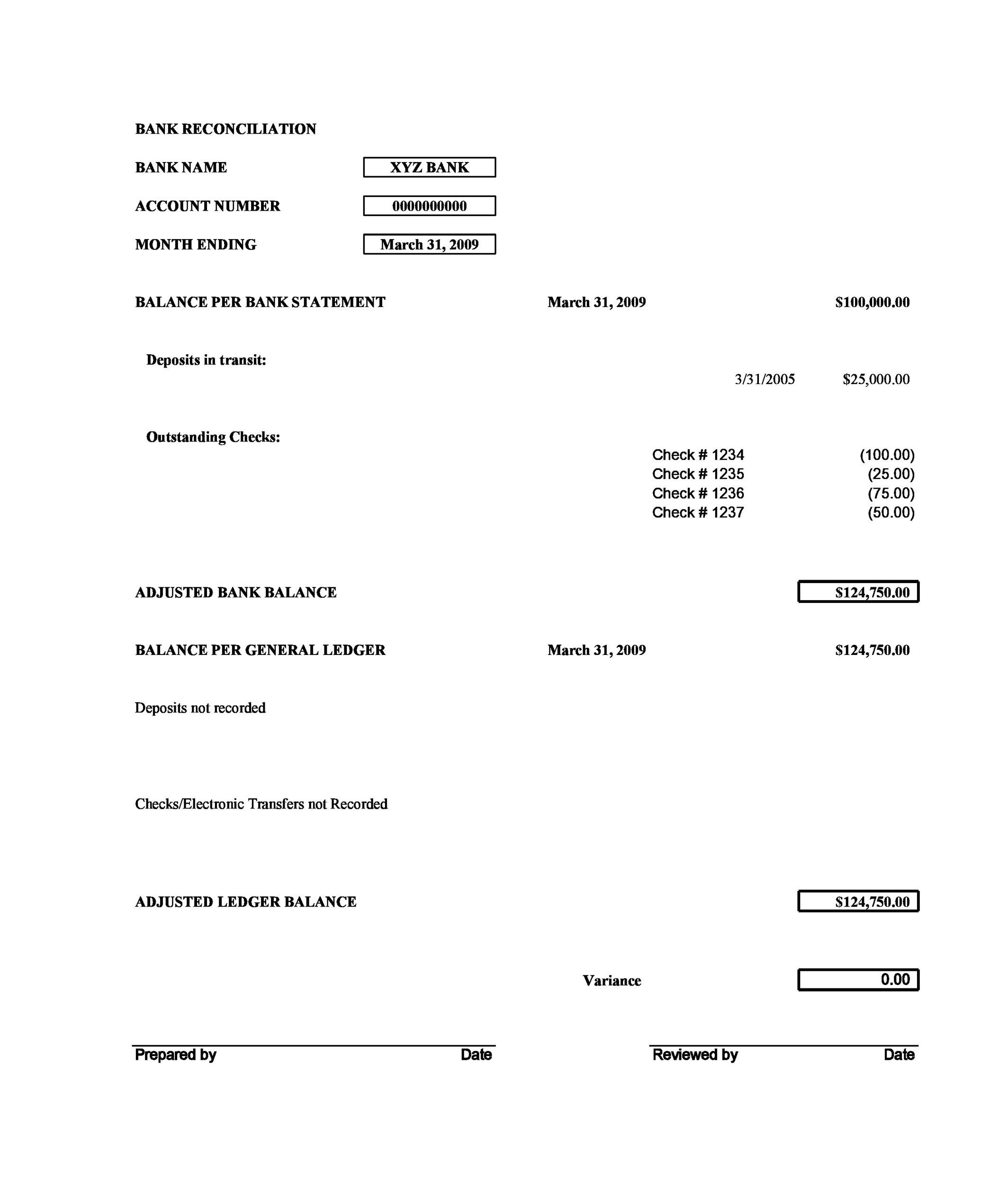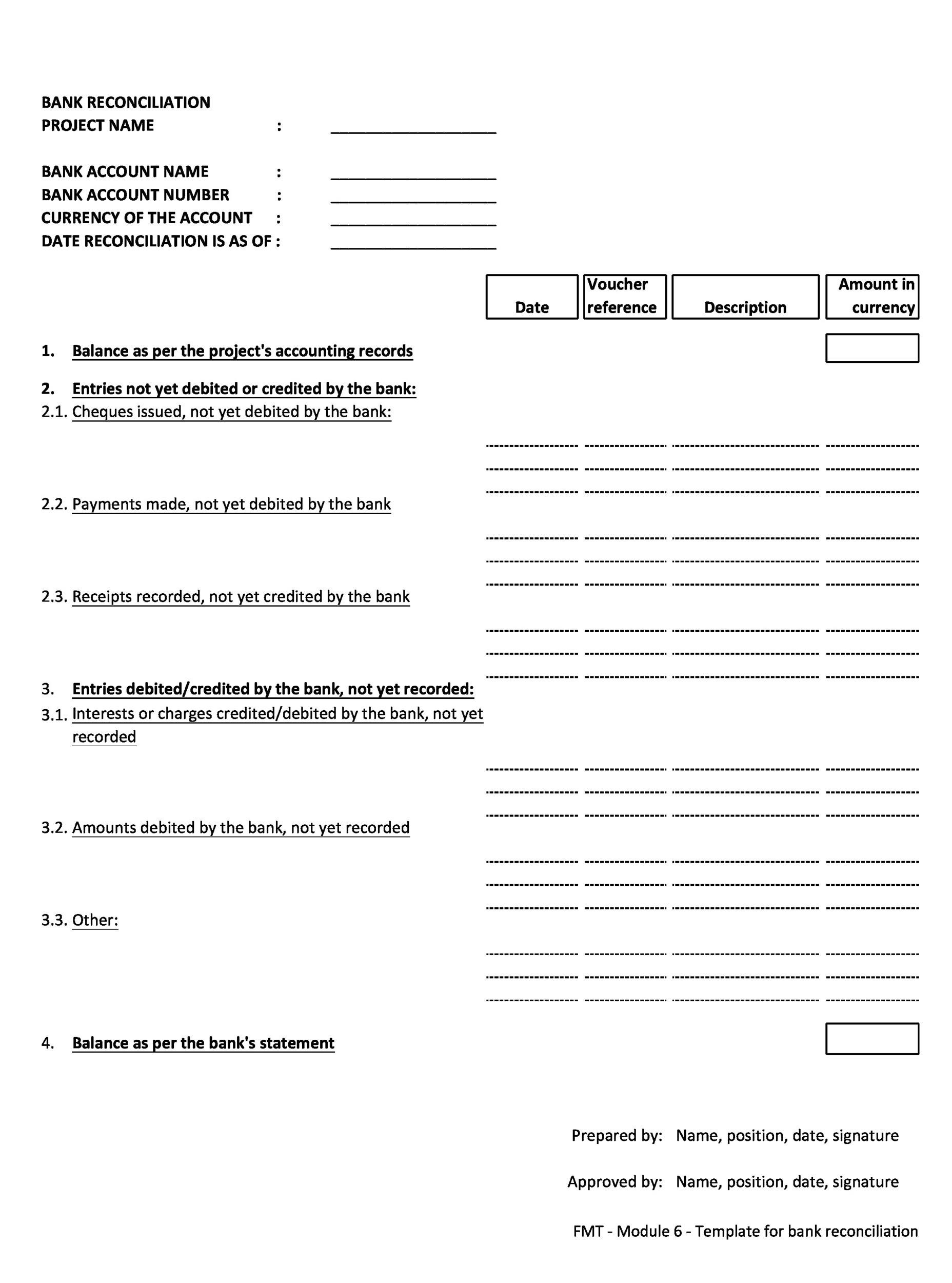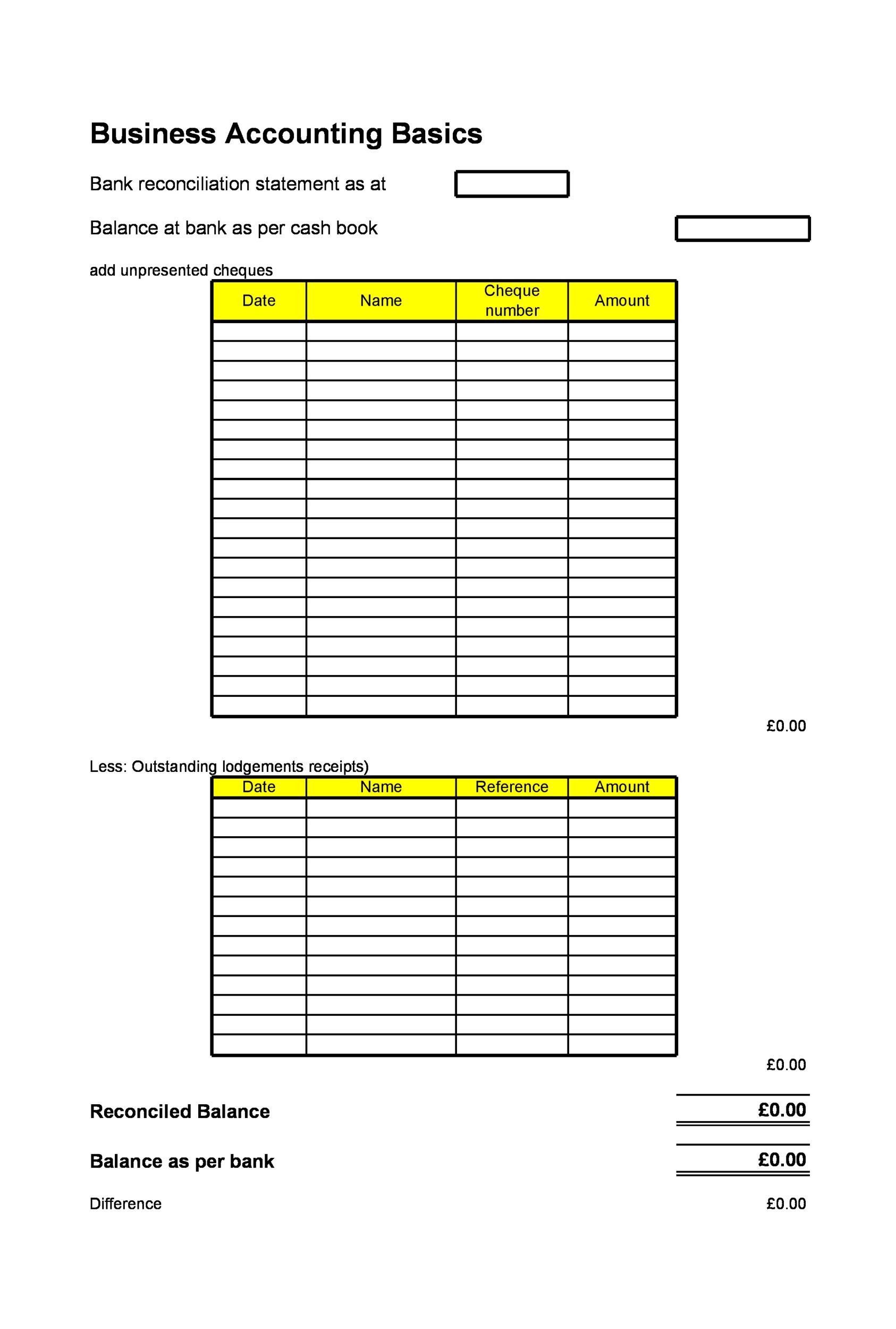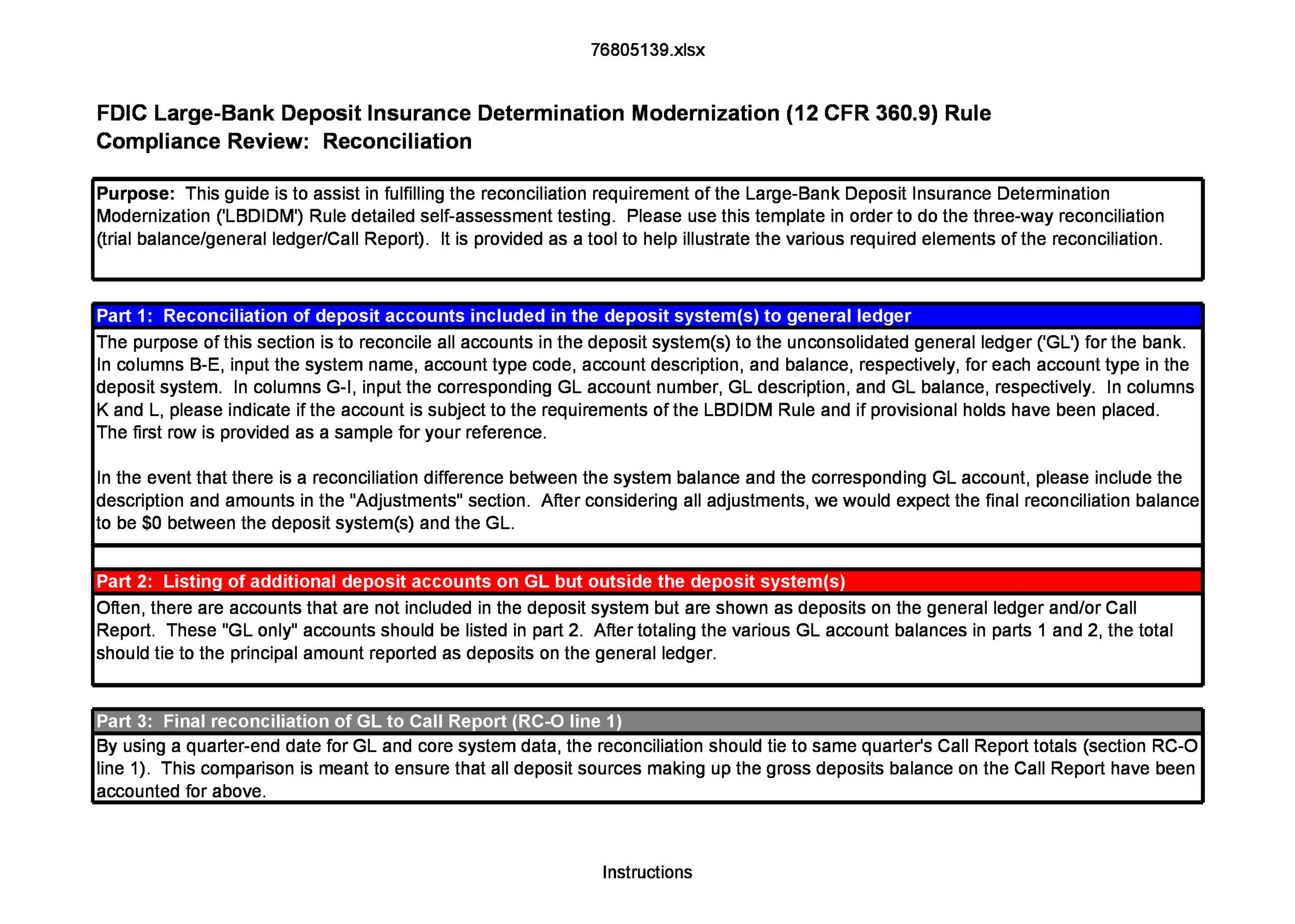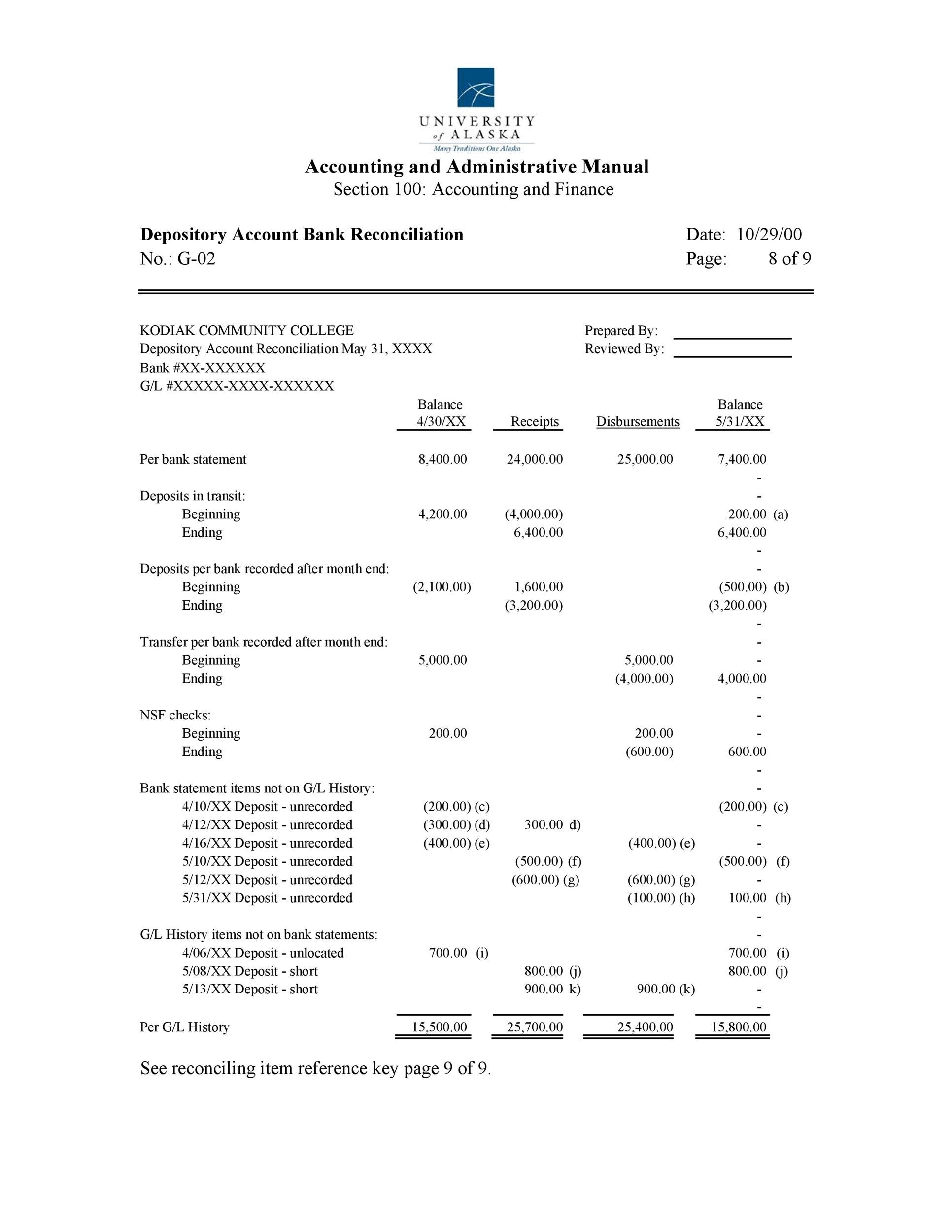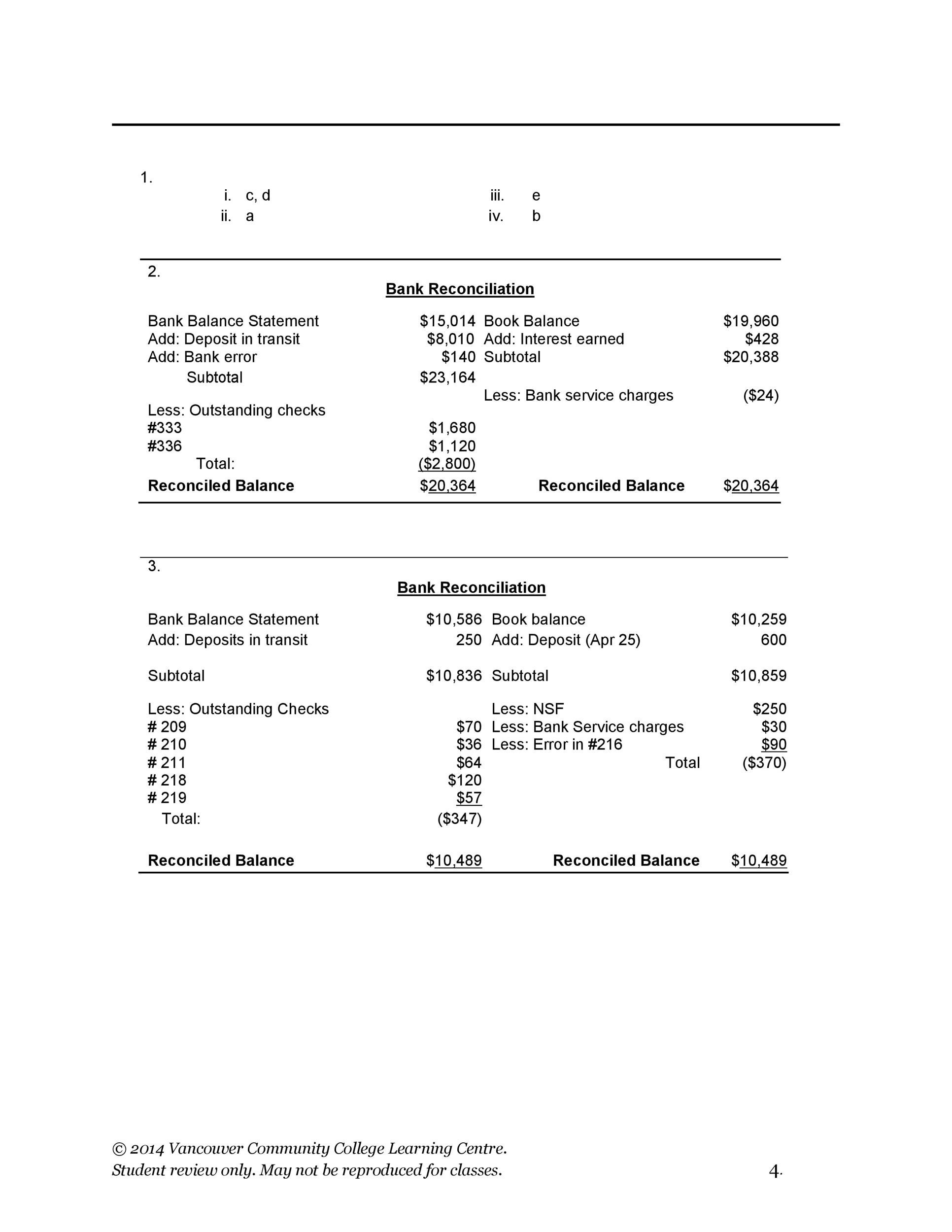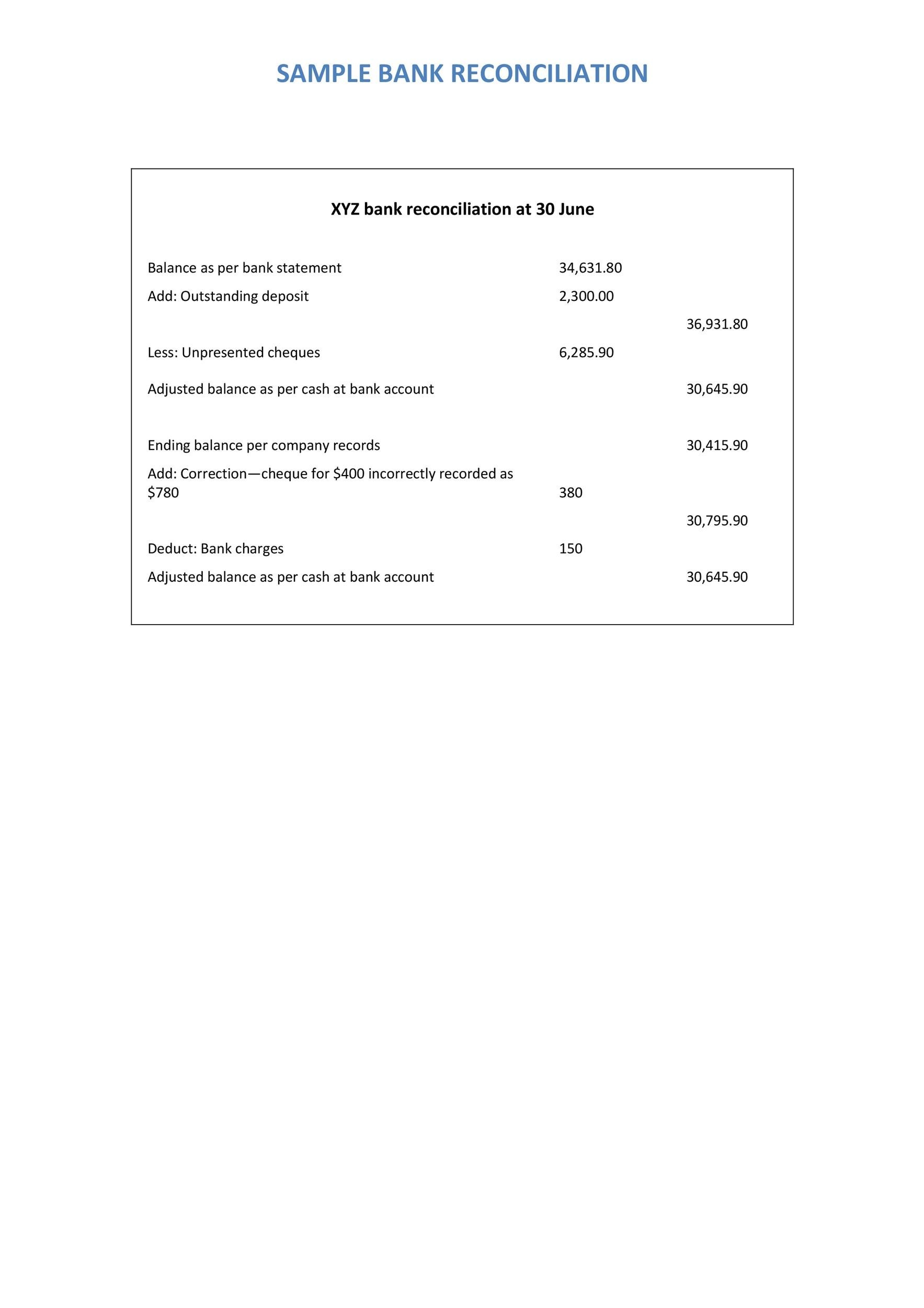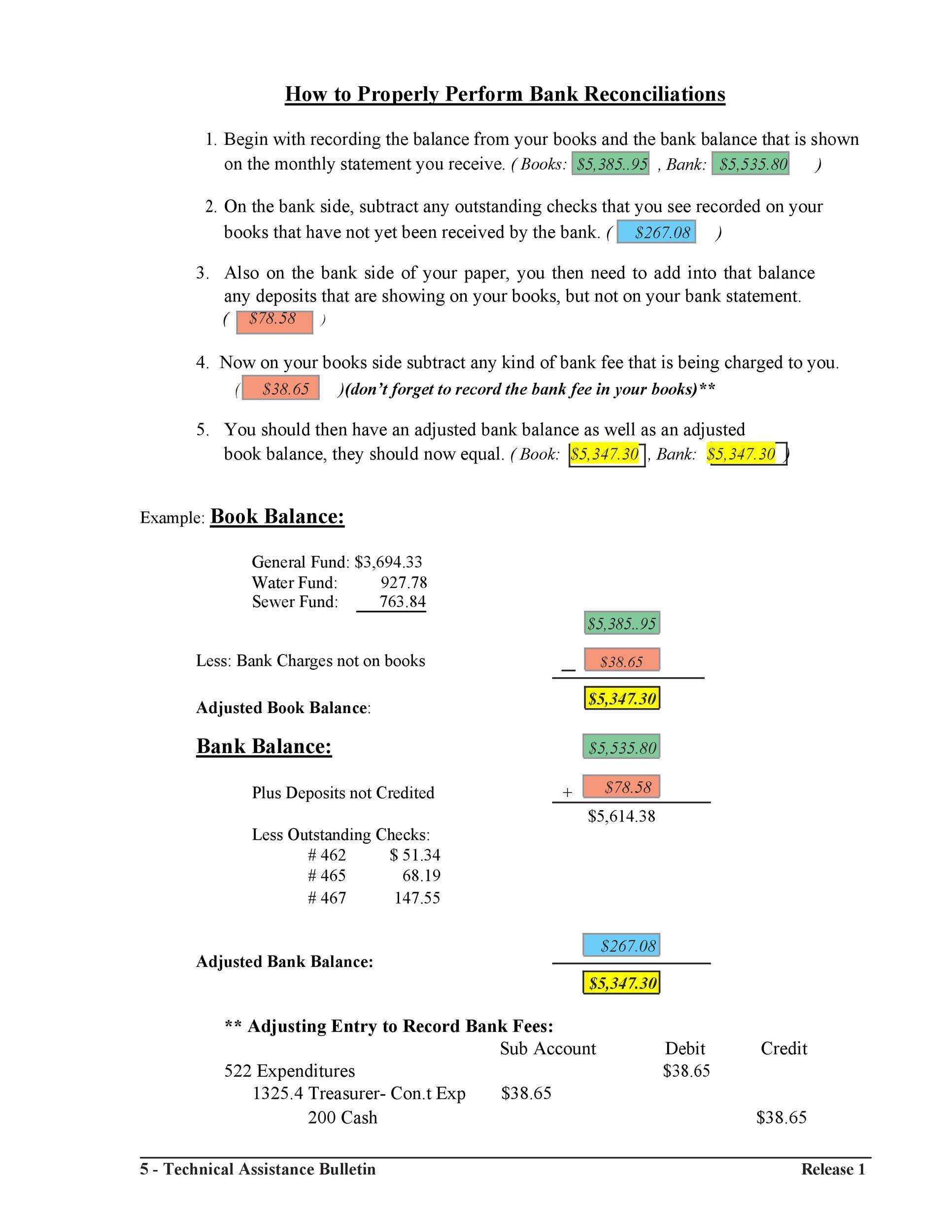When dealing with different transactions with your bank, it would be extremely helpful for you to know different bank processes as well. Let’s take for instance, bank reconciliation. Do you know what it’s all about and what it entails? Before we take a look at a bank reconciliation example, let’s first discuss its definition.
Table of Contents
- 1 Bank Reconciliation Examples
- 2 The Importance of Bank Reconciliation
- 3 Bank Reconciliation Forms
- 4 The Purposes of Bank Reconciliation
- 5 Bank Reconciliation Templates
- 6 Benefits of Bank Reconciliation
- 7 Bank Reconciliation Statement
- 8 Steps and Tips in Preparing Bank Reconciliation or a Bank Reconciliation Form
In bookkeeping, bank reconciliation is actually a process which gives explanation in any discrepancy on a specific date between the bank balance displayed in a company’s bank statement as given by the bank and the equivalent amount displayed in the company’s own records for accounting.
In cases when there are discrepancies, it could be because of:
- Errors made either by the bank or the company itself.
- The company may have issued some checks which were not shown to the bank.
- There had been a transaction with the bank (such as a fee charged by the bank or a credit which had been received) which has not yet been documented in the company’s books.
Bank Reconciliation Examples
Usually it’s quite easy to settle the discrepancies just by taking a look at the most current transactions found in the bank statement or the accounting records of the company then checking if a combination of them matches with the discrepancy which needs explanation. If the discrepancy cannot be explained through this way, you may have to go through all the transactions in the bank and company’s records and match them starting from the last reconciliation you’ve done to find out which transactions are different.
Once found, you would have to make adjustments in your accounting records (cash books), make a report to the bank if needed or use the discrepancies to guide you with reconciliations you’ll be making in the future. To make your work a lot simpler, it would be a good idea to familiarize yourself with bank reconciliation templates and bank reconciliation forms so that you will be able to do bank reconciliations regularly for your company.
This article will help you learn all about bank reconciliation, bank reconciliation forms and even how to prepare a good bank reconciliation example. Read on to learn all about this process and be guided when you will start making your own bank reconciliations in the future.
The Importance of Bank Reconciliation
Bank reconciliation is an important process for companies to do in order to check if there are any differences between the records of the company and the records of the bank transactions in the bank statements. Aside from this, there are other important reasons why it would be essential for you to do bank reconciliation and to learn how to use bank reconciliation templates.
- Regular bank reconciliation will allow you to immediately see if there are any differences or errors either in your company records or in the bank’s records.
- Realistically speaking, in a company, cash is probably the most vulnerable asset you have. Performing bank reconciliations would give you the power to take control of this extremely valuable asset and help protect it by early detection of irregularities like unauthorized withdrawals from the bank. Of course, for the process of control to function effectively, it would be essential to clearly define and separate the responsibilities of the people in charge of accounting and authorizing transactions with the bank from the duties of the people who are in charge of preparing and keeping track of the bank reconciliation statements.
- You would be able to feel secure once you know that all your records match with the records shown on the bank statements when you regularly check them through bank reconciliation. Being updated and knowing that all your accounting is in order would be one less thing to worry about in your company.
- When you put someone in charge of monthly bank reconciliation, you would be able to monitor the cash flow of your company regularly and you would be able to determine if you are doing well or if your company or business is in trouble.
- You would be able to use your bank reconciliation form to verify that all the data in your company’s accounting records are accurate as compared with the bank transactions. A good bank reconciliation example would also allow you to check if there are any unnecessary delays in the collection and/or clearance of checks.
- Regular bank reconciliation would allow for early detection and correction of any mistakes made in your company records. It would also serve as an indication for you to update your accounting records if you have seen that some entries have not yet been recorded.
These are the most important reasons why you should be carrying out regular bank reconciliations in your office. Without it, or if you would do it at intervals which are fairly far apart, it would require a lot more effort on your part especially if you discover a number of discrepancies or errors in your records. Now let’s move on to the purpose of doing bank reconciliation.
Bank Reconciliation Forms
The Purposes of Bank Reconciliation
As you can see, it is very important for you to regularly carry out bank reconciliation so that you are aware of where your funds are and where they are going at the end of each month. If you are updated with your cash flow, you will be able to handle your business a lot better. Bank reconciliation serves a lot of purposes, which you must know if you want to start doing this process in your company. These are the different purposes:
To be Updated Regarding Your Bank Account Balance
For you to be able to determine your actual bank account balance, you would have to reconcile your bank account with all your checks, withdrawal and deposit records. Your bank balance statement might not show the payments which you have made which have not yet been subtracted from the balance posted.
To avoid overdrawing from your account and to be able to ensure that you have enough money to cover all the withdrawals you need to make for your payments or for spending money, you have to know your actual bank account balance.
To be able to Discover Problems Which You May Not be Aware Of
When you regularly perform bank reconciliation, you would be able to review your bank account statements against your company’s personal records and see if there are any errors or problems. These errors may be caused by bank automation or even human errors.
These errors could be in the form of inaccurate deposit or withdrawal amounts, transposed numbers or other errors which can affect the amount of your total checking account. In doing monthly bank reconciliation, you will be able to discover these errors immediately and since you’d only have to review monthly statements and records, you won’t have to take too much time in analyzing. Doing bank reconciliations monthly would also allow you to meet your deadlines for reporting any differences or errors to your bank.
To be able to Identify Any Checks Which Haven’t Been Encashed Yet
Any undiscovered checks which haven’t been encashed could potentially cause problems for you, financially. In cases wherein checks get lost in the mail, get detached from a payment stub for a bill or are forgotten entirely, they end up not getting encashed or deposited in the bank, either in your account or as a payment you need to make to someone else.
In doing bank reconciliation at regular intervals, you are sure that you won’t have any outstanding checks so all your deposits and all your payments to creditors are updated. Uncashed checks can also lead to you overdrawing your account especially if you forget these outstanding obligations and you only use your checking account statement as your reference.
To be able to Efficiently Carry Out Internal Auditing
Most businesses and organizations use bank reconciliation routinely in their finance and accounting departments. To be able to ensure that your internal auditing is accurate, you would have to do the same. Whether you own a small company or a large one, you’d have to do regular bank reconciliation as part of the internal audit processes in order to manage your cash flow well and be updated regarding all your finances.
To be able to Review Your Finances
If you do monthly or regular bank reconciliation, it would serve as an informal review of all your finances. Reconciling your records of what you are spending and what is being deposited to your account would permit you to clearly see how cash flows in your company and establish whether you are earning more than you are spending or vice versa. This review would allow you to be updated in terms of financial information, which would help you manage your finances more efficiently.
These are the purposes of doing regular bank reconciliation. As you may now have realized, it’s really important for businesses, whether big or small. Now let’s take a look at the different benefits of carrying out bank reconciliations.
Bank Reconciliation Templates
Benefits of Bank Reconciliation
The importance and purpose of bank reconciliation may already be enough to convince you to start performing this process in your company. But there’s more – we will now be discussing the different benefits of bank reconciliation, which may further encourage you to learn more about it. Here are the different benefits of bank reconciliation:
For Detection of Fraudulent Activity
Bank reconciliation is basically matching the accounting records of a company to their bank accounts and statements. Upon discovery of any discrepancy, you would have to start searching for the cause of it or the reason behind it. Usually you will be able to find the reason – which would either be checks which have not yet been posted, interest added on an account or other such reasons. However if you cannot find the cause for the discrepancy, there may have been fraudulent activity in your company.
For Avoiding Overdraft
There are times when bank statements are not updated as cash outflow tends to lag. In cases when your company is operating on minimal funding reserves, you would need to know how much money you have at the most current time so you would avoid overdraft or spending more than what you have. If you do monthly bank reconciliation, you will be able to manage your finances much more efficiently and avoid issuing checks which would most likely bounce or end up being NSF checks.
For Identifying Errors Made by the Bank
Banks are not perfect institutions and neither are the people who work in them. There may be cases when bank errors are committed by the system or by the people handling the transactions. In doing regular bank reconciliation, you would be able to identify these errors early on and inform your bank that the errors exist. In doing this, you will also be able to see whether the errors have been made by the bank or your own people.
These are some of the most important benefits of doing bank reconciliation regularly. Now let’s apply everything and start learning how to actually prepare bank reconciliation.
Bank Reconciliation Statement
Steps and Tips in Preparing Bank Reconciliation or a Bank Reconciliation Form
Now that you know all about bank reconciliation as well as the importance, purpose and benefits of them, let’s take a look at some steps and tips in preparing a good bank reconciliation example. You would need these steps and tips to guide you especially when you are not used to using a blank bank reconciliation template.
- The very first step would be to thoroughly inspect your bank statement balance. You can do this by obtaining all you bank statements as soon as they are available. Usually, if you are registered online, you would have a quicker access to your bank account and your bank statements.
- Once you have your statements, take a note of the month-end balance. You would have to check if your bank balance and your company account records match, meaning all transactions would appear on all the records.
- To help you out, when you’re looking at your bank statement, any withdrawal from your bank account could be referred to as “debits” while any deposits made to your bank account would be referred to as “credits.” These terms and definitions would be different from how they are used in accounting.
- If you find a transaction which only appears in one record, either in the bank statement or your own records, then this would be considered as a “reconciling item.” Your main objective would be to establish the reason why there is such an item and make corrections until your records match.
- Prepare your bank reconciliation form first by adding onto the bank balance to make up for any deposits which may not have been recorded or posted yet. The reason for this is that there may be a delay between the time you have made a deposit at the bank and the time your deposit has been posted as an addition to your bank account.
- Next, you would have to decrease the bank balance to make up for any or all of your outstanding checks. Outstanding checks, or checks which have not yet been cleared by the bank, would need to be deducted from your bank balance.
- Be sure to check your previous month’s statement to ascertain that any outstanding checksfrom the previous month have already been cleared. If the check hasn’t been cleared yet, contact the payee to be able to find out why however is the checks remain outstanding even after a month, it may already be lost.
- Confirm if there are any errors committed by the processing department of the bank. If you are making reconciliations for a cash account of your business, all your transactions would probably be posted on a general ledger. The person or people responsible for bank reconciliations in a company should compare the general ledger to the activities in the bank statement. If you see any unclear bank transactions, you would have to contact your bank.
- If the discrepancy isn’t because of a bank error and you cannot find the explanation for it, then there fraudulent activity may have occurred.
- To be able to adjust your general ledger balance, you should first confirm if all checks have already been posted. Once your company receives the bank statement, print out a report which would list all the checks which have been written and all the deposits which have been made during the month.
- Take a look at all the checks you have issued in numbered order. Confirm that the checks have been posted in your bank statements. If your checks had cleared, indicate that in your accounting records. When you’re done with looking at all your checks, you should already have a list of all the checks (along with all the important details of the checks) which do not appear on your bank account or bank statements. These outstanding checks are reconciling items.
- Verify that all your deposits have already been posted. Print out a list of all the deposits which you have made for the whole month. The list should come with corresponding deposit slips in order for you to be able to reconcile them.
- Once you are done with reviewing your deposits, make a separate list of all deposits which do not appear on your bank account or are not posted on your bank statements. Include the amount of the deposit as well as the date it has been made. These deposits in transit are reconciling items.
- Keep in mind that you would have to deduct any and all automated debits or service charges and fees. Typically these charges are posted on your bank statement but may not be posted on your cash account at the end of the month. You’d also have to make adjustments to your cash account records for any interest which is earned on your bank account balance.Interest amounts to be added as well as charges and automated debits which won’t appear yet on your records would be reconciling items.
- Make sure to carefully check if you had made any errors during the month. As you compare your records to your bank statements, you might discover some errors which you had missed previously. These errors would be reconciling items.Work on reconciling all the items until all your records match and there are no more discrepancies.







